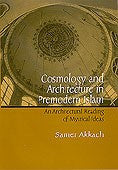



About
Cosmology and Architecture in Premodern Islam An Architectural Reading of Mystical Ideas Samer Akkach - Author Summary A fascinating exploration of how the transcendent is expressed in the spatial sensibility of premodern Islam. This fascinating interdisciplinary study reveals connections between architecture, cosmology, and mysticism. Samer Akkach demonstrates how space ordering in premodern Islamic architecture reflects the transcendental and the sublime. The book features many new translations, a number from unpublished sources, and several illustrations. Referencing a wide range of mystical texts, and with a special focus on the works of the great Sufi master Ibn Arabi, Akkach introduces a notion of spatial sensibility that is shaped by religious conceptions of time and space. Religious beliefs about the cosmos, geography, the human body, and constructed forms are all underpinned by a consistent spatial sensibility anchored in medieval geocentrism. Within this geometrically defined and ordered universe, nothing stands in isolation or ambiguity; everything is interrelated and carefully positioned in an intricate hierarchy. Through detailed mapping of this intricate order, the book shows the significance of this mode of seeing the world for those who lived in the premodern Islamic era and how cosmological ideas became manifest in the buildings and spaces of their everyday lives. This is a highly original work that provides important insights on Islamic aesthetics and culture, on the history of architecture, and on the relationship of art and religion, creativity and spirituality. The topic is highly significant and the value of the book lies in the new material that is unavailable elsewhere. There is no equal to this book, in my experience. — Keith Critchlow, author of Islamic Patterns: An Analytical and Cosmological Approach Samer Akkach is Senior Lecturer in History and Theory of Architecture at the University of Adelaide, Australia, and the Founding Director of the Center for Asian and Middle Eastern Architecture. Table Of Contents Illustrations Note to the Reader Preface Introduction Abbreviations 1. Discursive Order Cosmology: An Overview Symbolism: A Critical Review History and Symbolism Sufism Symbolism: A Sufi Perspective 2. Metaphysical Order Being and Presence The Primordial Presence The Divine Presence The Human Presence The Epitome of Creation The Presence of the Word 3. Cosmic Order The Original Idea Creative Breathing The “Cloudâ€Ã‚ and Cosmic Forms The World of Command The World of Creation 4. Architectural Order Gazing at the Sky Ordering Spaces Architecture and the Sacred The Ka’ba: The First House The Mosque and the Spatiality of Prayer Afterword: Architecture and Cosmic Habitat Notes List of Arabic Manuscripts Cited Selected Bibliography Index
Cosmology and Architecture in Premodern Islam An Architectural Reading of Mystical Ideas Samer Akkach - Author Summary A fascinating exploration of how the transcendent is expressed in the spatial sensibility of premodern Islam. This fascinating interdisciplinary study reveals connections between architecture, cosmology, and mysticism. Samer Akkach demonstrates how space ordering in premodern Islamic architecture reflects the transcendental and the sublime. The book features many new translations, a number from unpublished sources, and several illustrations. Referencing a wide range of mystical texts, and with a special focus on the works of the great Sufi master Ibn Arabi, Akkach introduces a notion of spatial sensibility that is shaped by religious conceptions of time and space. Religious beliefs about the cosmos, geography, the human body, and constructed forms are all underpinned by a consistent spatial sensibility anchored in medieval geocentrism. Within this geometrically defined and ordered universe, nothing stands in isolation or ambiguity; everything is interrelated and carefully positioned in an intricate hierarchy. Through detailed mapping of this intricate order, the book shows the significance of this mode of seeing the world for those who lived in the premodern Islamic era and how cosmological ideas became manifest in the buildings and spaces of their everyday lives. This is a highly original work that provides important insights on Islamic aesthetics and culture, on the history of architecture, and on the relationship of art and religion, creativity and spirituality. The topic is highly significant and the value of the book lies in the new material that is unavailable elsewhere. There is no equal to this book, in my experience. — Keith Critchlow, author of Islamic Patterns: An Analytical and Cosmological Approach Samer Akkach is Senior Lecturer in History and Theory of Architecture at the University of Adelaide, Australia, and the Founding Director of the Center for Asian and Middle Eastern Architecture. Table Of Contents Illustrations Note to the Reader Preface Introduction Abbreviations 1. Discursive Order Cosmology: An Overview Symbolism: A Critical Review History and Symbolism Sufism Symbolism: A Sufi Perspective 2. Metaphysical Order Being and Presence The Primordial Presence The Divine Presence The Human Presence The Epitome of Creation The Presence of the Word 3. Cosmic Order The Original Idea Creative Breathing The “Cloudâ€Ã‚ and Cosmic Forms The World of Command The World of Creation 4. Architectural Order Gazing at the Sky Ordering Spaces Architecture and the Sacred The Ka’ba: The First House The Mosque and the Spatiality of Prayer Afterword: Architecture and Cosmic Habitat Notes List of Arabic Manuscripts Cited Selected Bibliography Index
Cosmology and Architecture in Premodern Islam
- Regular price
- $24.95
- Sale price
- $24.95
- Regular price
-
Couldn't load pickup availability



